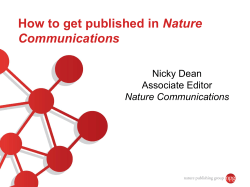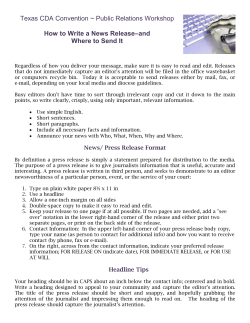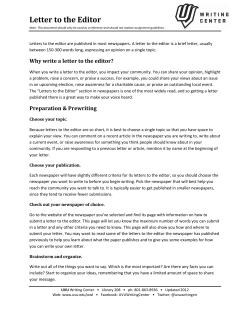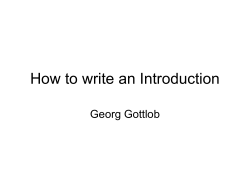
How to Write a Scientific Article Lecture 6 Francois Grey
Tsinghua Workshop on How to Write a Scientific Article Lecture 6 Francois Grey November 2008 Conclusions of Lecture 5 Choose the journal early, and consider factors like speed of publication and impact factor. A new class of high impact journals has emerged for physics and nanotech since 2001. Note that reviews also have a high impact factor. Familiarize yourself with the (online) submission procedure of the most likely journal(s) for your. This may affect many practical decisions you make (size, number of figures etc.) Make sure you understand the copyright form (waiver) that you fill out, and its consequences for subsequent use of your own material. Consider open access journals where appropriate. Overview of the Course Eight lectures + homework 1) Historical Context 2) Contemporary Context 3) Planning Your Article 4) Writing Your Article 5) Submitting Your Article 6) The Referee Process 7) Disseminating Your Article 8) Conclusions Lecture 6: The referee process • • • • • Origins of peer review Roles of editors and reviewers How it works How to react Proofing and reprints Origins of peer review • • • Peer = equal (not your superior) Referee = a person you ask about something (refer something to) Reviewer = look at again • 1665: Royal Society starts Philosophical Transactions. Editor is sole responsible. Objective is to document results for those not present at Society meeting. • 1752: Royal Society adopts review process, uses select members. • 19th century: Academies institute committees to review incoming manuscripts . • 1890s: carbon paper enables rapid replication for multiple reviews. • 20th century: peer review extends outside membership academies, societies .(Einstein 1905 papers reviewed by editors only!) Role of editors and reviewers • The Editor remains sole responsible for decision to publish, referees provide expert opinions which the editor uses to make his decision. • The Managing Editor: full-time professional, deals with technical issues. • Scientific Editors: scientist (volunteer), deals with content issues. Your main contact person during peer review process. • Editorial Boards: first line of referees. They also select other referees. • Referees/reviewers/editorial consultants: Experts in your field. • Manuscript editor/copy editor: deals with technical and style improvements to accepted articles. How it works Editor reviews manuscript How it works Editor reviews referee reports, makes decision Modify: may require major changes (<50%) Final acceptance rate: PRL <35% Nature <10% How to react What to do if you are asked to modify: • Strategic decision: do you want to make the changes proposed? Are you able to do so in the time available? • Tactical decision: Which changes can you argue effectively against? How is the editor likely to view your arguments? What to do if rejected (unacceptable in present form): • Strategic decision: Is the problem due to something missing or flawed? Can you fix this by further work? • Tactical decision: How long can you afford to wait for publication? Special cases (handle with care): • Reviewers split (one for, one against). • One reviewer seriously misunderstands (part of) your article. • One reviewer clearly biased (<1% of cases). Rebuttal: A letter that replies point by point to the criticisms made by the referees. How to react Above all, remember: • The editor makes the decision, not the referee. • The editor and referees are in principle on your side. Some tips: • Keep any rebuttal as short and as fact-based as possible. Avoid any speculation about referees’ intelligence! • Start always with your strongest rebuttal points, and keep discussion of items you cannot deal with brief. • Be respectful, even when saying that the referee is wrong (use “sandwich” method: positive – negative – positive ). • Keep close track of progress of your article during the referee process, complain (respectfully) if there are delays. Proofing and reprints Proofing • Read proofs very carefully. Read backwards. Only correct errors – no change to article contents. • Follow proofing instructions carefully and respond to proofing queries promptly. This is your responsibility. • Exceptionally, an addendum to mention a new article you have learned about since submission can be made. Reprints • Use these for promotion of your results to scientists (to referenced researchers, at conferences). • Distribute pdf version and make available on web sites – but ensure you are within copyright rules. Conclusions of Lecture 6 Peer review is part of a process to establish the accuracy, novelty and importance of the results you wish to publish. The editor consults the reviewers, but the editor makes the final decision, which can be accept, modify or reject. If asked to modify your article or if it is rejected, consider carefully whether it is worth resubmitting or trying another journal. How likely is it that this will be accepted on resubmission, and how long will this take? Always treat editor and referees with respect, even when you disagree. Remember that they are there to improve your article. Follow the production process carefully and complain if there are delays. Pay particular attention to the proofing process. Class exercise Read first 3 pages of manuscript • • Does this article have a clear message? Does it satisfy the 3 PRL criteria? 1) Importance: does it change understanding of topic and lead to progress in subfield? 2) Interest: will the result be important to other readers in other subfields? 3) Accessibility: is it easy for non-experts to understand the importance and interest? Homework for next lecture Continue planning and writing your article!
© Copyright 2025





















